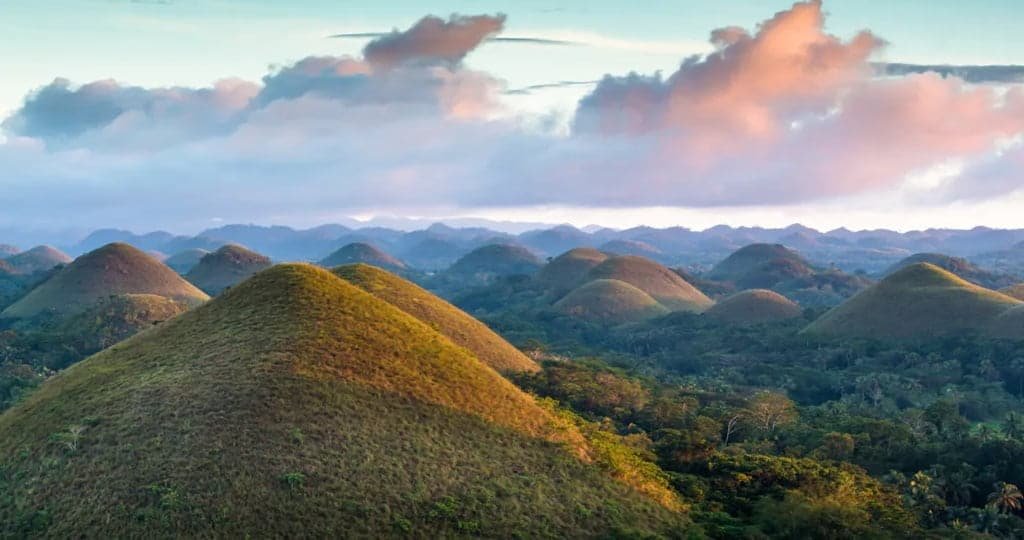Have you ever heard of a natural wonder that looks like a landscape made of chocolate? If you still need to, you must learn about the Chocolate Hills in the Philippines. This geological formation is a popular tourist attraction located in the Bohol province.
The Chocolate Hills consist of thousands of cone-shaped hills with a height ranging from 30 to 120 meters, spread over an area of more than 50 square kilometers.
The hills are covered in green grass, but during the dry season, the grass dries up, turning the mountain into a chocolate-brown color. Keep reading to learn more about this unique geological formation that is a must-see on your Philippines vacation.
Geographical Location of the Chocolate Hills
The Chocolate Hills are a geological formation located on the island of Bohol in the Philippines. Bohol is one of the most popular tourist destinations in the country, known for its beautiful beaches, historic churches, and unique natural wonders such as the Chocolate Hills.
Bohol is a small island in the central Visayas region of the Philippines. It is located southeast of Cebu, another popular tourist destination, and southwest of Leyte. The island is approximately 50 kilometers long and 22 kilometers wide, with a total land area of 4,821 square kilometers.
Bohol is accessible by air and sea. The island has its airport, the Bohol-Panglao International Airport, which serves direct flights from major cities in the Philippines and some international destinations. There are also several ports in Bohol, including the Tagbilaran City Port, which serves ferries and fast crafts from neighboring islands.
To get to Bohol, fly from Manila or Cebu to the Bohol-Panglao International Airport or take a ferry from Cebu to Tagbilaran City Port. Once in Bohol, you can hire a car or motorcycle to explore the island and visit the Chocolate Hills.
Formation and Geology
The Chocolate Hills are a geological formation in the Bohol province of the Philippines. The hills consist of over 1,200 conical mounds, each varying in height from 30 to 50 meters. These mounds are made of limestone and are covered with lush green vegetation, which gives them their iconic chocolate color.
Related: The 60 Best Things To Do in Hocking Hills
Limestone Origin
The Chocolate Hills were formed from the uplift of coral deposits and the subsequent erosion of the surrounding area. The limestone that makes up the hills was formed from the accumulation of shells and other skeletal fragments of marine organisms. Over time, these deposits were uplifted by tectonic forces and exposed to the elements, resulting in the formation of the hills.
Karst Topography
The Chocolate Hills are an excellent example of karst topography, characterized by the dissolution of soluble rocks such as limestone, dolomite, and gypsum. The dissolution of the limestone in the Chocolate Hills has resulted in the formation of numerous sinkholes, caves, and underground rivers.
These features are important from a geological perspective and have significant ecological and cultural value. Sig The significance of the Chocolate Hills lies in their unique geological formation and the legends and myths surrounding them.
According to local folklore, the hills were formed from the tears of a giant who had lost his love. While the legends may mask a scientific explanation for the hills’ formation, the geological processes that created them are no less fascinating.
Visitor Information
If you plan College Hills, here is what you need to know before you go.
Opening Hours
The Chocolate Hills are open to visitors every day from sunrise to sunset. Visiting early in the morning or late in the afternoon is recommended to avoid the day’s heat.
Viewing Decks
There are several viewing decks today that heat the Chocolate Hills complex. These decks offer stunning views of the hills and surrounding landscape. Some popular viewing decks include the Sagbayan Peak, Carmen View Deck, and Chocolate Hills Complex.
Accessibility
The Chocolate Hills are accessible by car or motorcycle. If you are uncomfortable driving, you can book a Chocolate Hills tour with a local operator. Remember that the roads leading to the hills can be narrow and winding, so it is important to drive carefully.
Related Read: 15 Best Fun Things to Do in Chapel Hill
Ecology and Biodiversity
The Chocolate Hills of Bohol are a natural wonder of geological significance and a rich ecosystem of flora and fauna. The hills are home to various endemic species adapted to the region’s unique environment.
Endemic Flora
The vegetation of the Chocolate Hills is predominantly composed of grasses, shrubs, and trees. The hills are covered in green grass that turns brown during the dry season, giving them their distinctive chocolate color.
Shrubs and trees, including the native Soho tree (Casuarina Equisetifolia) of the Philippines, are scattered among the grasses. There are other tree species in the area as well, such as the molave (Vitex parviflora), narra (Pterocarpus indicus), and banaba (Lagerstroemia speciosa).
Fauna
The Chocolate Hills are also home to various animal species, including several endemic birds and mammals. One of the most notable bird species is the Philippine tarsier (Tarsius syrichta), a small primate known for its large eyes and unique vocalizations. The tarsier is native to the Philippines and is found only in a few regions, including the Chocolate Hills.
There are other bird species in the area as well, such as the Philippine cockatoo (Cacatua hemiplegia), Philippine eagle (PithecophagaJefferyi), and Philippine pygmy woodpecker (Dendrocopos maculatus). Numerous mammal species can also be found in the hills, such as the Philippine brown deer (Cervus mariannus) and the Philippine flying lemur (Cynocephalus volans).
Nearby Attractions
If you’re planning a trip to the Chocolate Hills, there are several nearby attractions that you will want to take advantage of. One of the most popular is Sagbayan Peak, which offers stunning views of the surrounding countryside.
You can take a cable car up to the peak or hike to the top for a more challenging adventure. In addition to the views, Sagbayan Peak has a butterfly sanctuary, a mini zoo, and a local restaurant.
Another nearby town worth visiting is Carmen, home to the famous Chocolate Hills Adventure Park. You can zip line, climb a rope course, or ride an ATV through the hills here. The park also has a butterfly dome, a museum, and a restaurant serving local dishes.
If you want to explore more of Bohol Island, head to Batuan, which is known for its historic churches and scenic countryside. You can take a guided tour of the town’s landmarks, rent a bike, and explore independently.
The Chocolate Hills and its surrounding areas offer many tourist attractions and activities. Whether you’re interested in adventure sports, cultural landmarks, or simply relaxing on the beach, you will surely find something to suit your interests.
Read More: Steps to Buy a Home in Cookhill Redditch
Best Time to Visit Chocolate Hills

The best time to visit Chocolate Hills is during the dry season, which runs from December to May. The hills turn into a showcase of its iconic chocolate brown look during these months. The least chance of rainfall is during April, making it the best time to visit Chocolate Hills and experience Bohol activities, such as swimming, snorkeling, and sightseeing, in the island province.
If you want to save money, June is the best time for low prices in Chocolate Hills. Hiring a car in Chocolate Hills costs $15 per day. This price varies by $5.4 depending on the month. In June, hiring a car costs an average of $11 per 24 hours, so this is the best time to save money!
Why Should You Visit Chocolate Hills?
If you plan a trip to the Philippines, visiting the Chocolate Hills is necessary. This natural monument is a famous tourist attraction and is considered one of the most remarkable natural wonders in the world. Here are some reasons why you should visit the Chocolate Hills:
- Iconic Hills: The Chocolate Hills are a group of over 1,200 hills spread over 50 square kilometers. These hills are cone-shaped and are made of limestone. During the dry season, the hills turn brown, giving them their name. Green trees surround them, but no trees grow on the hills themselves. The view of the hills is breathtaking and is something you will remember easily.
- Adventure Activities: If you’re an adventure junkie, you’ll love the Chocolate Hills Adventure Park. You can try zip-lining, rope courses, and other exciting activities here. The park also has a butterfly dome, a mini zoo, and a restaurant where you can enjoy local cuisine.
- Natural Beauty: The Chocolate Hills are not the only attraction in the area. You can also visit the nearby rivers, caves, and waterfalls. The site is home to a diverse range of flora and fauna, including the Philippine tarsier, one of the smallest primates in the world.
Visiting the Chocolate Hills is an experience you will remember. The natural beauty, cultural significance, and adventure activities make it a must-visit destination in the Philippines. So pack your bags and head to the Chocolate Hills for an unforgettable vacation.
Read Also: Top 25 Biggest Statues in The World in 2024
Travel Tips And Recommendations
Chocolate Hills is a must-see if you’re considering taking a vacation in the Philippines and want to go to Bohol. To help you get the most out of your trip, consider these travel suggestions and advice:
- Know Before You Go: The Chocolate Hills are a geological formation of over 1,000 conical hills spread over 50 square kilometers. The best time to visit is during the dry season, from December to May. There are several ways to get to the Chocolate Hills, including hiring a private car, joining a tour, or renting a motorbike. Entrance fees are affordable, and there are no additional fees for taking photos.
- Where To Stay: The Chocolate Hills are accessible almost anywhere in Bohol. Even if you’re staying on the coast at Anda Beach or Panglao Island, many tour agencies will take you, commonly on a day tour, including the Tarsier Sanctuary, Manmade Forest, Loboc River, and more.
- What To Wear: The Chocolate Hills are in a tropical climate, so it’s best to wear light, comfortable clothing. Bring sunscreen, a hat, and sunglasses to protect yourself from the sun. Wear comfortable shoes if you plan to hike up to the viewing deck.
- What To Bring: Bring a camera or smartphone to capture the breathtaking views of the hills. Also, bring a bottle of water to stay hydrated during your visit.
- Hiking Tips: If you plan to hike to the viewing deck, be prepared for a steep climb. Wear comfortable shoes and take your time. There are multiple naps and stops where you can catch your breath and take in the scenery.
- Tour Guide: If you want to learn more about the history and geology of the Chocolate Hills, consider hiring a local tour guide. They can provide valuable insights into the formation of the hills and the local culture.
Follow these travel tips and recommendations to make the most of your visit to the Chocolate Hills in Bohol, Philippines.
What Is Special About Chocolate Hills?
Here are some of the reasons why Chocolate Hills is special:
- Unique geological formation: The Chocolate Hills is a rare geological formation not found anywhere else. It is believed to be formed by the uplift of coral deposits and the action of rainwater and erosion over millions of years.
- Natural wonder: The Chocolate Hills is a natural wonder that attracts thousands of tourists annually. It is a popular destination for nature lovers, hikers, and photographers.
- Biodiversity hotspot: The Chocolate Hills is home to a rich biodiversity of flora and fauna. It is home to several endemic species of plants and animals, including the Philippine tarsier, one of the world’s smallest primates.
- Cultural significance: The Chocolate Hills is an important cultural landmark in the Philippines. It symbolizes the country’s natural beauty and is a source of pride for the local people.
- Adventure activities: The Chocolate Hills offers several adventure activities, including hiking, biking, and zip-lining. Visitors can also explore the nearby caves, waterfalls, and beaches.
Also Read: 6 Best Places To Visit In Mysore
How Many Steps Does Chocolate Hills Have?
If you want a bird’s eye view of the Chocolate Hills, you must climb up to the viewing deck at the polls. To reach the deck, you’ll have to climb 214 steps.
While the climb may be a bit strenuous, the view from the top is worth it. From the deck, you’ll see the rolling hills stretching out as far as the eye can see.
It’s important to note that the steps leading up to the viewing deck are quite steep, so it’s recommended that you wear comfortable shoes and take your time climbing up. Once you reach the top, you’ll be rewarded with a stunning panoramic view of the Chocolate Hills.
Frequently Asked Questions (FAQs) about Chocolate Hills
How were the Chocolate Hills formed?
The Chocolate Hills were formed by the uplift of ancient coral reefs and the action of rainwater and erosion. Over time, the limestone formations were exposed and weathered, creating the unique, conical hills we see today.
What is the total count of the hills in the Chocolate Hills complex?
The Chocolate Hills complex consists of over 1,200 hills spread over approximately 50 square kilometers in Bohol, Philippines.
What makes the Chocolate Hills a unique geological formation?
The Chocolate Hills are a unique geological formation due to their symmetrical, cone-shaped appearance and uniform height and spacing. They are also composed of limestone, a rare type of rock for this type of formation.
Can visitors hike on the Chocolate Hills, and are there designated trails?
Visitors can hike on the Chocolate Hills, and designated trails are available. However, visitors are advised to stay on the trails to avoid damaging the fragile ecosystem of the hills.
What is the local mythology surrounding the origin of the Chocolate Hills?
According to local mythology, the Chocolate Hills were formed by two giants who threw rocks and boulders at each other in a rage. After they became tired and reconciled, they left the hills as a reminder of their battle.
Does the vegetation of the Chocolate Hills include trees, or is it mostly grass?
The vegetation of the Chocolate Hills is mostly grass, which turns brown during the dry season, giving the hills their chocolate-like appearance. However, some trees and other vegetation are also growing in the area.
Are There Trees in Chocolate Hills?
No, there are no trees in the Chocolate Hills. The hills are mostly grass and shrubs, with very few trees. This is due to the hills’ unique geological formation, making it difficult for trees to grow.
Conclusion
You have now learned about the unique geological formation of the Chocolate Hills in Bohol, Philippines. These cone-shaped hills are made of limestone and are spread over an area of more than 50 square kilometers. While there may be as many as 1,776 hills, there are at least 1,260 hills in the area.
Visitors to the Chocolate Hills can enjoy various activities, such as hiking, biking, and zip-lining. The Chocolate Hills Adventure Park offers thrilling activities for adventure enthusiasts and nature lovers.
To fully appreciate the beauty of the Chocolate Hills, visiting during the dry season from December to May is recommended. During this time, the hills turn brown and resemble chocolate kisses, hence the name “Chocolate Hills.”
Bohol is also home to other natural wonders, such as the Tarsier Sanctuary and the Hinagdanan Cave. It is a must-visit destination for travelers seeking adventure and natural beauty.
















[…] Related: Chocolate Hills […]
Comments are closed.